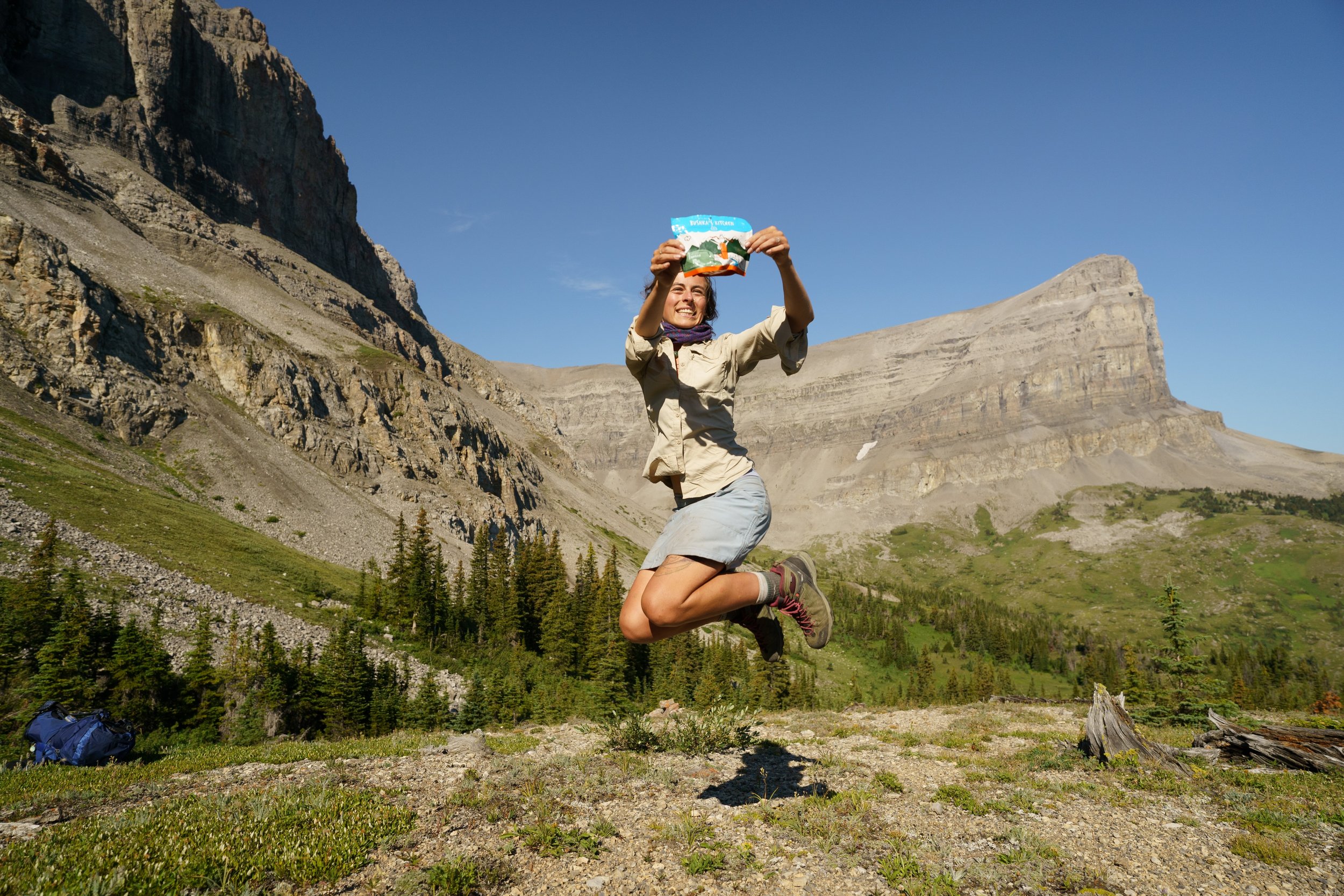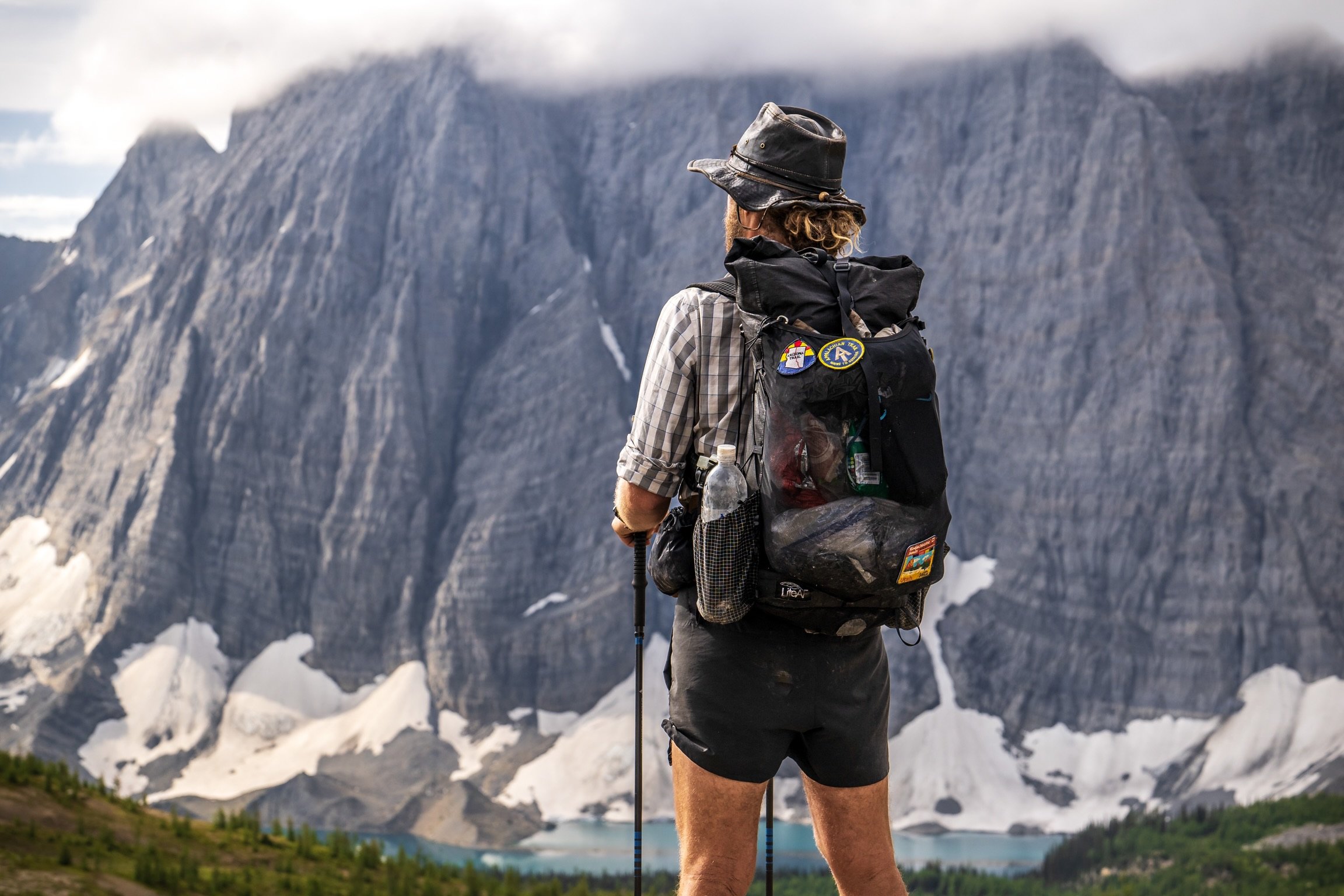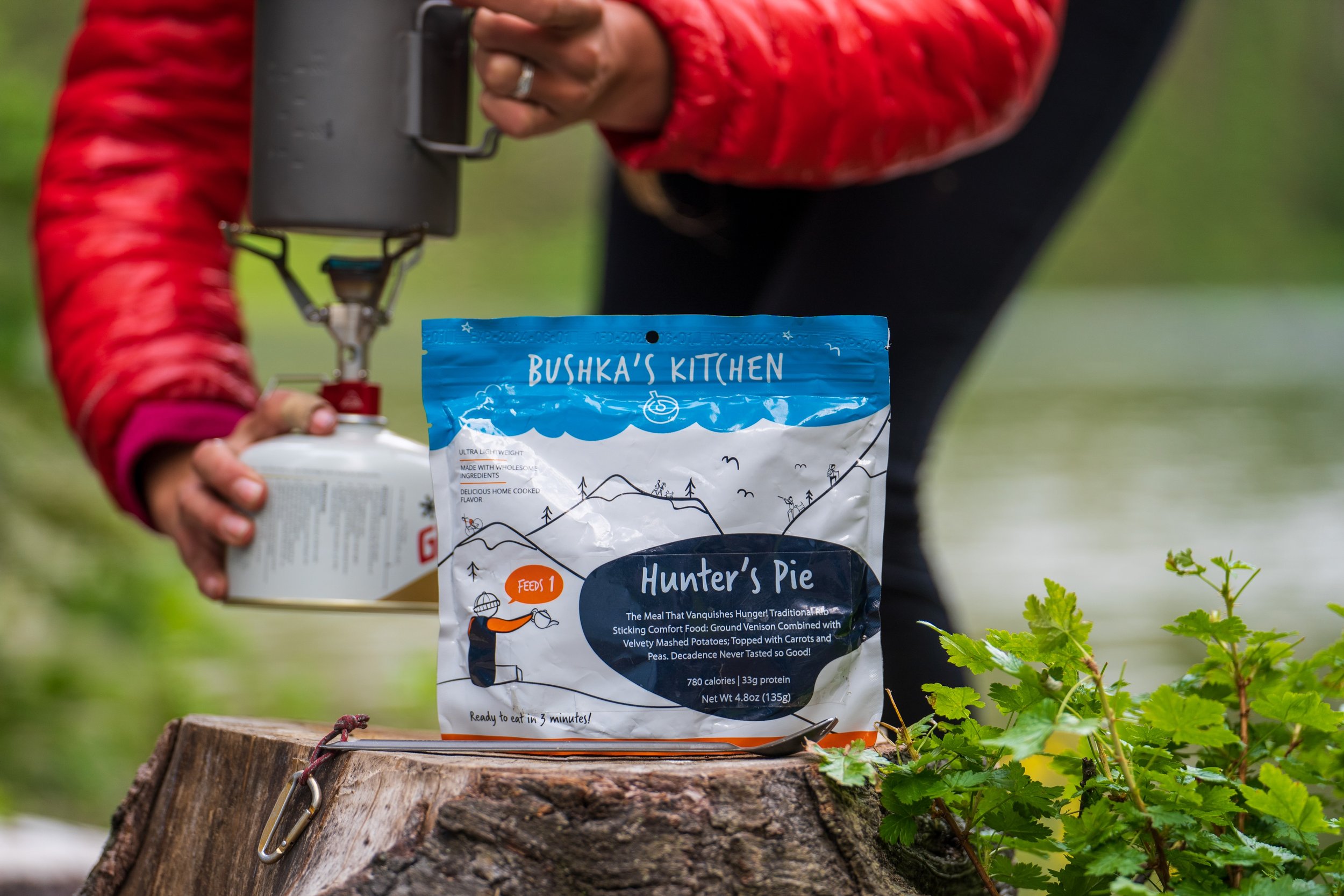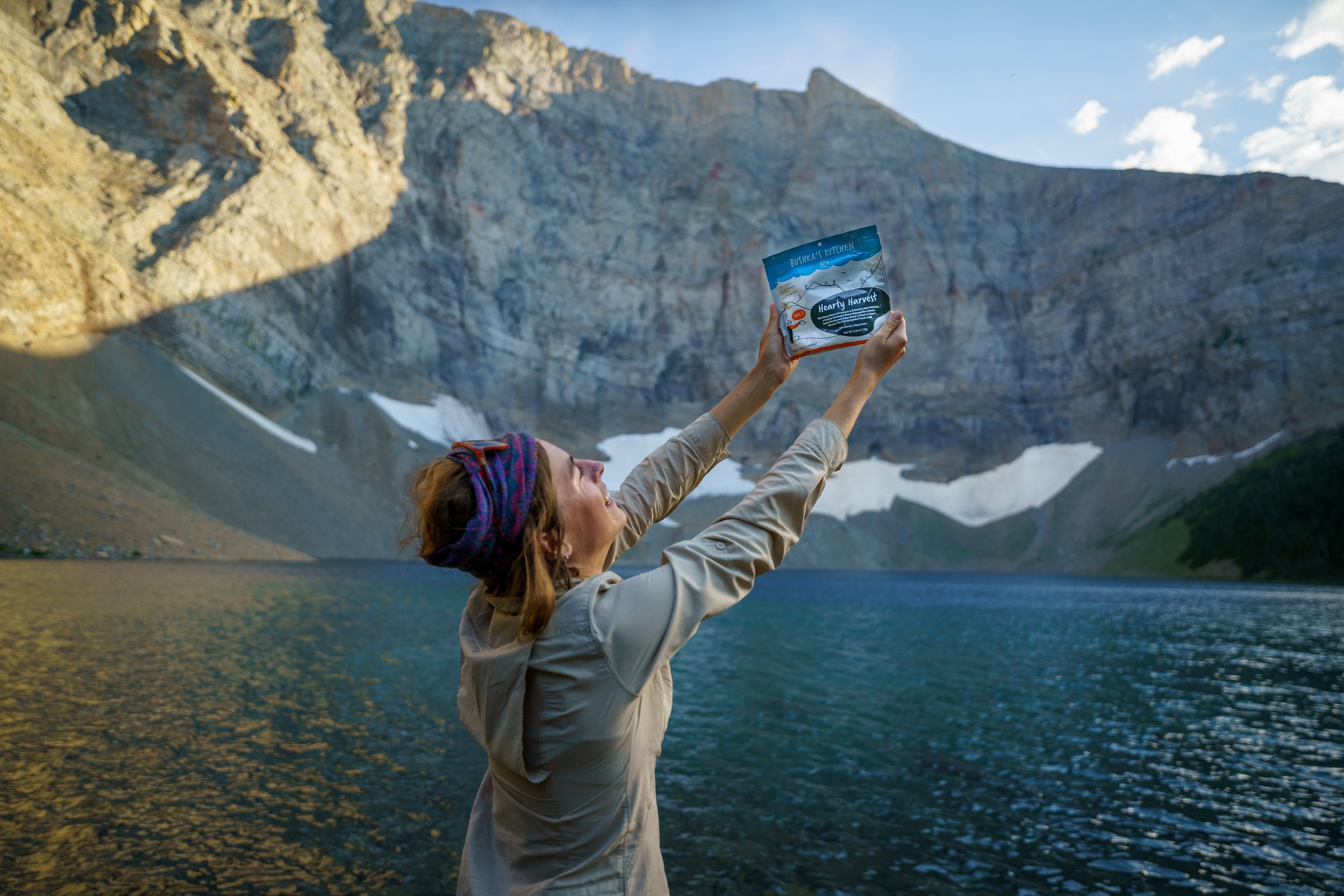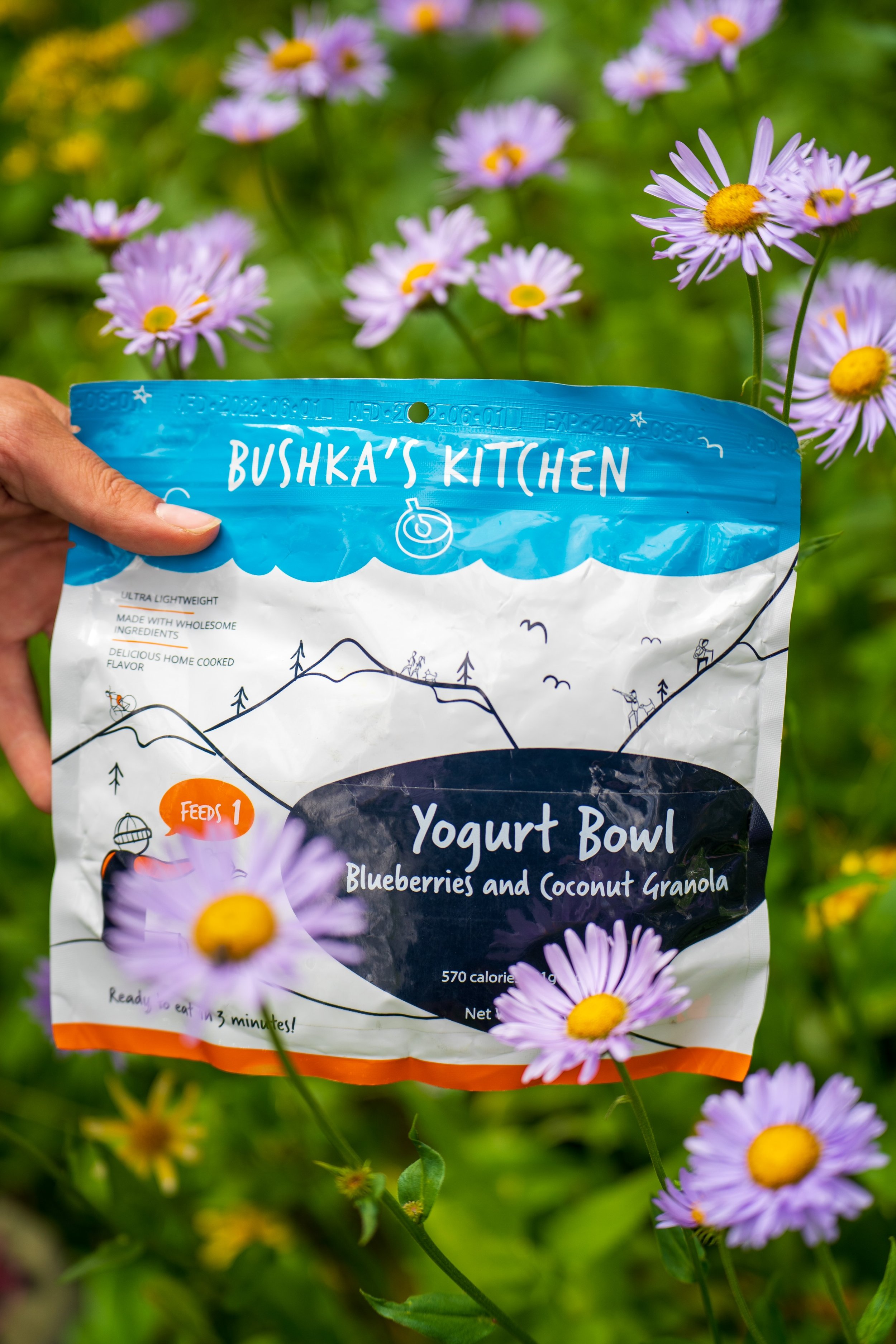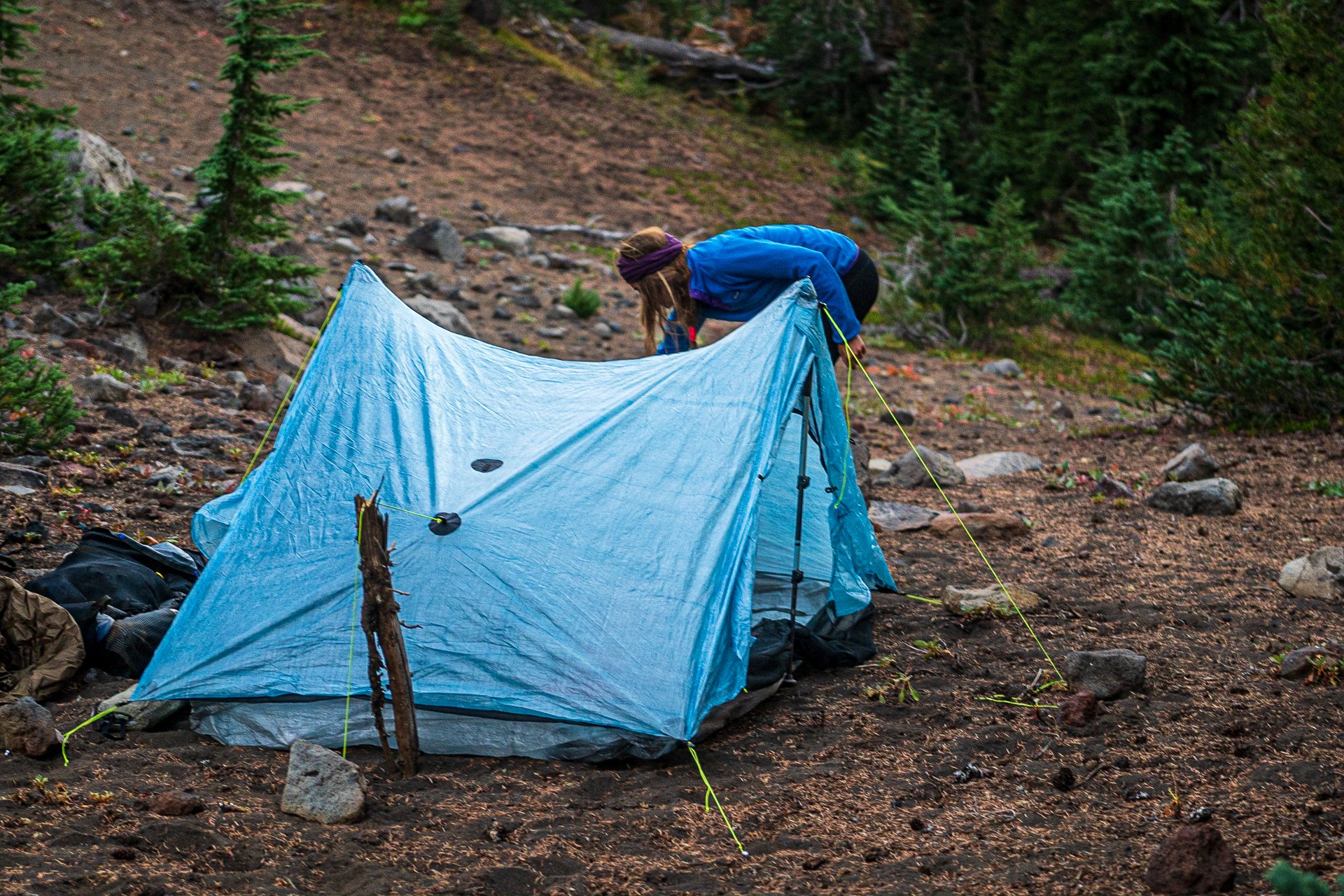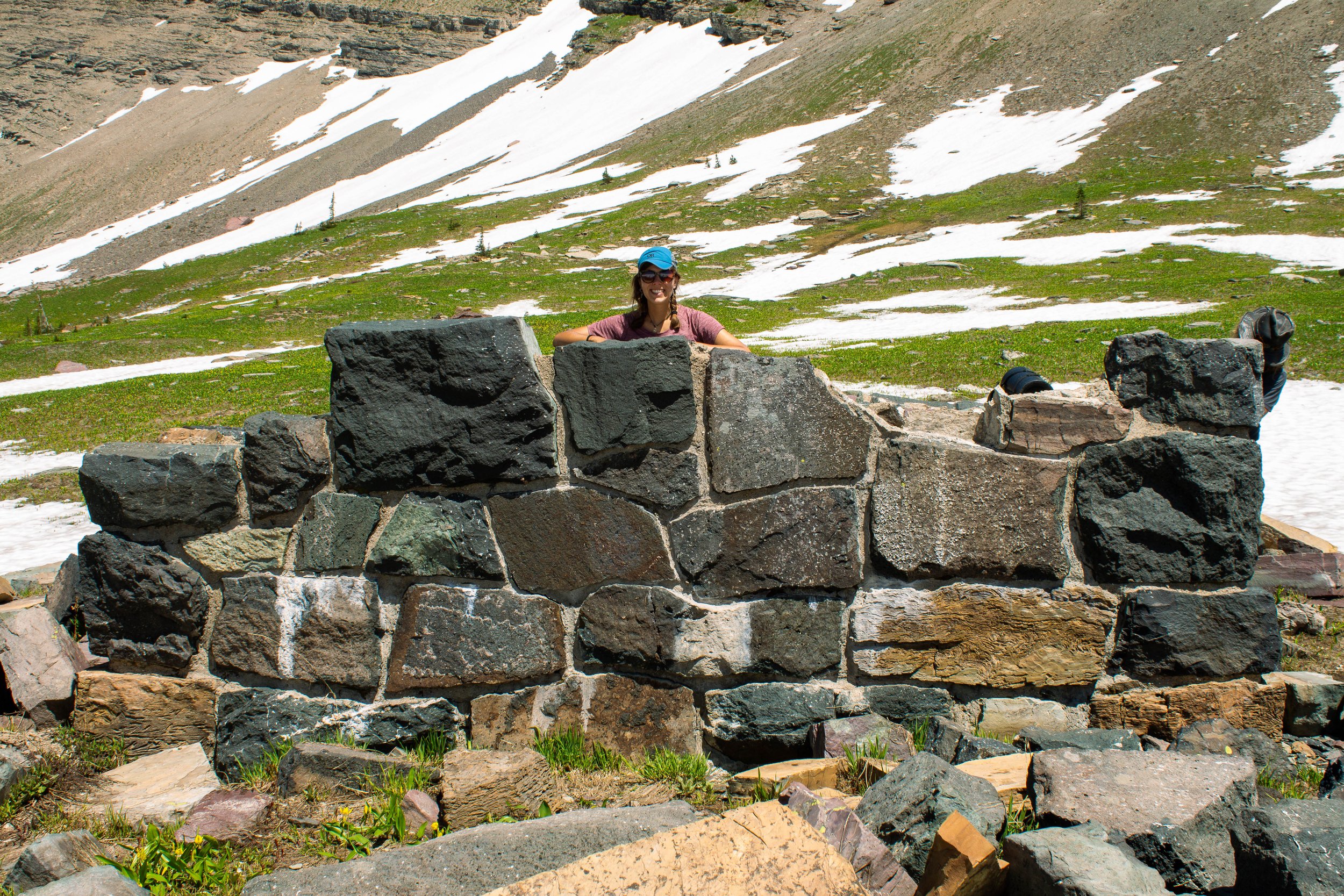Backpacking Food | Bushka’s Kitchen
Backpacking food: There’s a lot to be said on the topic. For us, it’s quite easy: We like our backcountry meals light, affordable, easy, tasty, and nutritious. Sounds familiar? ;-)
For long outdoor adventures, we usually stack up on ramen, mashed potatoes, and Knorr rice and pasta sides. But every now and then, we indulge in proper backpacking food, if only to support all the amazing local & food-conscious companies out there. That is why we were thrilled to be working together with Bushka’s Kitchen for our 2022 adventure of the Great Divide Trail in Canada.
We carried Bushka’s meals for our first two weeks of the Great Divide Trail. From the start, we were thrown into the Canadian Rockies and faced daily elevation gains of 1500 m (5,000 ft), scrambly ridge walks, and 12 hour-hiking days. So, needless to say, we needed all the calories and fats we could get. When you are scrambling on steep, rugged terrain, you can easily burn up to 900 calories/hr. That means it is necessary to pay attention to what and how much you eat. Bushka’s meals are full of fats and proteins: Just what you need for your backcountry adventure!
Whereas most backpacking meals take about 8 to 10 minutes to prepare, Bushka’s dinners require only 3 minutes of waiting time. The perfect time to blow up your sleeping pad or switch to your camp socks! We found the portions to be generous, and we happily shared a meal every night, together with some couscous or ramen.
The bags are lightweight, can be used as meal pouches, and are easily reused as garbage bags. Oh, and the colors are fun, too. What’s not to like?
Entrées | Venison, Bison or Vegetarian: Choose your Pick
Ryan and I used to eat plant-based, but over the last few years, we prefer to eat meat and fish again. That is why we absolutely loved the Hunter’s Pie. The taste of the ground venison together with mashed potatoes, carrots and peas was amazing. A true comfort meal, heartwarming and just what you need after a long, exhaustive day. Hunter’s Pie proudly boasts 780 cal. and 33g of protein.
Attention, meat lovers: If this made your ears ring, be sure to try the Hearty Harvest. This hearty meal has it all: Wild boar (?!), creamy mushroom basmati rice, apple chunks, and green beans. Yep, this is fine dining in the backcountry. This meal has about 570 cal. and 30g of protein in it. For the Italian fans, there is the Unstuffed Pepper, a true Italian dish with San Marzano tomato sauce, espresso-salted bison (yes, bison), bell peppers, green onion & quinoa. With 570cal and 31g of protein, this dish will make you want to move mountains.
The vegetarian options are pretty impressive, too. There’s the risottos’ and chilis that we all know, but Bushka’s changes the game and introduced us to the Zesty Zoodles and Lentil Lunch. The Zesty Zoodles (540 cal, 11g protein) does not only have a funky name, but is also a funky dish! It is a pasta dish with chunks of zucchini and cherry tomatoes, but it is the avocado sauce with a twist of lemon that makes this entrée very interesting. Refreshing, to say the least.
We loved to have the Lentil Lunch for, well, lunch! It was a nice break from the ramen and peanut-butter-wraps. After 3 minutes of cold-soaking, you had yourself a healthy lentil meal, spiced up by dill vinaigrette, cucumbers, apple, onion, and bell peppers. A really refreshing lunch on trail, perfect for a quick lunch break. With 600 cal and 29g of protein, you are fuelled up for the rest of the day.
If you’re a potato lover, then the Sweet Potato Mash and Mashed Potatoes are your go-to. The Mashed Potatoes tasted creamy and buttery and easily serve to 2 people. The Sweet Potato Mash was spiced with cinnamon (that’s me!), clove and Vermon maple syrup, giving it a surprisingly sweet touch.
What are our favorites?
Easy question: The Yogurt Bowls, Banana Bites and the Hearty Harvest stole our hearts!
While we usually are not the biggest breakfast fans on trail - we like to sleep in - we did manage to get up a little earlier for Bushka’s Yogurt Bowls. You can choose between Raspberries & Almond Granola and Blueberries & Coconut Granola. Both have Dahi whole milk yoghurt, organic oats, and maple syrup. Just fill up the bag with cold water, let it soak for 3 minutes - et voilà! In late summer, you can even pluck some wild berries and spice up your yogurt bowl. The Yogurts boast 570 cal. and 21g of protein each.
True, dried banana chips are a classic when it comes to backpacking snacks. Yet, Bushka’s Banana Bites (110 cal, 1g protein) are simple and yet so good. The bites melt in your mouth, taste fresh and natural, plus they make an excellent combo with the Yogurt Bowls and Rice Puddin’!
Blog sponsored by Bushka’s Kitchen
The End of the GDT | Back to life, back to reality…
And so our journey in the Canadian wilderness has come to an end. On September 24th, somewhere around noon, Ryan and I stumbled onto Highway 16 between Prince George and McBride. The food was all gone, water bottles were nearly empty and our brains foggy. We started sticking our thumbs out, and much to our surprise, we got picked up within 5 minutes.
Two days before, we reached the official end of the Great Divide Trail in Kakwa Provincial Park. At km 1095, you reach Kakwa Lake and its wooden cabin, a magnificent end to a magnificent hike… But unless you have fancy friends with a float plane, you still need to hike another 100 km to exit the remote park and catch a ride on Hwy 16. Kakwa Park is accessible by foot, bike, or horse only. No cars or ATVs allowed: The park promotes pure, untouched wilderness.
Our first driver, 90-some years of age, didn’t exactly pull over, but stopped in the middle of the road. He beckoned us to come in and put our packs in the car. Semi-trucks were driving by, angrily honking their horns, but our dear driver did not seem to care nor hear it. Originally from the U.K., he moved to Canada 70 years ago and loved it. He dropped us off at an old-school diner in McBride, where we indulged in the most amazing burgers and poutine. About 6 coffee refills later, we were fuelled up for the next leg of the journey. Although the hiking part was officially over, we still had + 500 highway kilometers to cover.
Hitchhiking in 2022
During our entire GDT adventure, we had over 20 hitches! Our conclusion? We are all just people in the end, and being kind to others is truly the coolest thing you can do - even in 2022.
Hitchhiking in Canada has been quite an adventure. Not only is hitchhiking pretty rare in 2022 - “we’re not living in the hippie 60s anymore” - but some highways don’t even allow picking up hitchhikers! Good thing that some people are still rebels and just want to help another human out. So in the end, we always had a ride out and were fortunate to meet people from all different walks of life.
After an hourlong wait in McBride, an A&W cook and his manager picked us up, gave us chocolate to munch on, and conveniently dropped us off in the direction of Jasper, where our third driver, a hard-working First Nation Saskatchewanian picked us up. He generously bought us food in KFC and drove us all the way to Hinton. The next day, a kind banker lady drove us to Edmonton. We listened to country music and talked about banks, dogs, and crazy technology. It was her first time picking up hitchhikers. We think she might do it again.
Hitchhiking after finishing the Great Divide Trail made our return to the “real world” gradual and gentle. However, it still feels like a shock. After a long period of solitude and simplicity, society and its multitude of impulses, people, smells, and sounds can be quite overwhelming.
Posing with our guardian angel
- made by Lynnie Wonfor
But we were lucky to spend a couple of nights with the Wonfors, the kindest and most caring family in Calgary. We learned again that connecting with the right people can be healing, too. ❤
So, what’s on the menu for October? Basically, editing and writing until we drop. After a two-week housesit and taking care of two dogs, we will hit the road again in mid-October. First, we head south to Phoenix for work in the desert. After that, we drive another 2,000 miles to Pittsburgh, where we meet up with Ryan’s family. We’ll say our goodbyes to the van and welcome a new chapter in Belgium… Aloha!
“So was I once myself a swinger of birches.
And so I dream of going back to be.
It’s when I’m weary of considerations,
And life is too much like a pathless wood
Where your face burns and tickles with the cobwebs
Broken across it, and one eye is weeping
From a twig’s having lashed across it open.
I'd like to get away from earth awhile
And then come back to it and begin over.”
(Excerpt from Robert Frosts’ Birches)
Packlist for Great Divide Trail- 2022
Pack and Gear list for Great Divide Trail Thru hike
Hey y’all! Here’s our gear list for the Great Divide Trail. Feel free to shoot us any questions or comments you have. Happy trails!
Ryan’s Gear List:
Pack & Poles:
Pack: LiteAF Ultra 40L Curve Full Suspension
Trekking Poles: Black Diamond Distance Carbon Trekking Poles
Camera Bag: HMG Camera Pod (small), REI Trail 5 Waist Pack (w/ camera insert), Peak Design Capture Clip
Sleep:
Tent (carried by Ilse!): Zpacks Duplex
Quilt: Enlightened Equipment 20˚ Enigma
Sleeping Pad: Thermarest NeoAir XL
Pillow: Sea to Summit Aeros Premium Pillow
Food & Water:
Filter: Katadyn Be-free
Bottles: 1.5L Smart Water x2
Bladder (for filter): HydraPak 2L Seeker
Food Bag: LiteAF FLAT BOTTOM BEAR BAG (LARGE)
Pot: MLD 950 ml Titanium Pot
Spork: Sea-to-summit Alpha Light Long Spork
Stove: MSR Pocket Rocket 2
Lighter: Bic Mini
Electronics / Camera:
Phone: iPhone 12mini
Headphones: Apple AirPods Pro
Watch: Garmin Fenix 6X
“Computer:” iPad Air (gen4) w/ apple pencil; 2x SSD’s, cables, SD card reader dongle
Camera: Sony A7C + Rocket Blower, lens cloths, 3x 128GB SD Cards, Peak Designs Capture Clip
Lenses: Sony 20mm 1.8G, Sony 50mm 2.5G, Tamron 70-180mm 2.8
Microphone: Rode VideoMic NTG
Tripod: Job Gorilla Pod Pro 3k
Battery Bank: Anker PowerCore Essential 20000 PD (18W)
Chargers: Anker USB-C Nano (20W) x3; charging cables (iPhone, micro, USB-C x2, Garmin)
Headlamp: Petzl Tikka w/ core rechargeable battery
Clothes:
Shorts: Nike Challenger Running Shorts (w/ pockets!)
Shoes: Salomon X Ultra 3 Mid GTX
Shirt: Synthetic T-shirt
Rain Jacket: Outdoor Research Helium
Puffy: Enlightened Equipment Torrid Vest (7D)
Wind Pants: Enlightened Equipment Copperfield Wind Pants
Socks: 3x Darn Tough
Hoodie: Sky Goat CAMP hoodie
Base Layer Pant: Patagonia lightweight
Hat: Buff (many purpose!)
Sun Sleeves: REI
Misc:
Hygiene: Toothbrush, toothpaste, floss, sunscreen, body glide, chapstick, TP
Shovel: Duece of Spades
Knife: Swiss Army Classic
Bear: Bear Spray, 3mm Accessory Cord (bear hangs)
First Aid / Repair: Gorilla Tape (~3m), Tenacious Tape, Patch kit (Sleeping Pad), Ibuprofen, Gauze / Bandages,
Ilse’s Gear List
Pack & Poles:
Pack: Osprey Eja 48
Trekking poles: Black Diamond Trail Ergo Cork
Fanny Pack: Decathlon
Sleep:
Tent: Zpacks Duplex (carried by me :) )
Sleeping Bag: Western Mountaineering Versalite
Sleeping Pad: Therm-a-Rest Neoair XLite
Food & Water:
Filter: Sawyer Squeeze
Water bladder: Platypus
Food bag: Ursack
Pot: Toaks Titanium 750 ML
Spork: Sea-To-Summit Delta
Stove: MSR Pocket Rocket 2
Electronics
Phone: Samsung Galaxy A22
Headlamp: Petzl Actik Core
Battery Bank: Anker PowerCore Essential 20000 PD (18W)
Clothes:
Bandana: Buff
Shoes: Salewa Alp Trainer 2
Underwear: Icebreaker + Decathlon
Socks: Darn Tough 2x + Injinji
Bra: Patagonia Barely Everyday
Base layers: Icebreaker 200
Puffy: Mountain Hardwear Ghost Whisperer
Rain Jacket: Outdoor Research Helium
Skirt: Patagonia Tech Skort
Shirt: Columbia Silver Ridge Long Sleeve
Hoodie: Skygoat USA
Misc:
Hygiene: Toilet paper, Deuce of Spades, Superglue, Ibuprofen, Kula Cloth, toothbrush + paste
Bear: Bear Spray, 3mm Accessory Cord (bear hangs)
Gloves + hat: Decathlon Fleece
Hiking in Glacier’s Backcountry
Visiting Glacier National Park in the summertime? Yep, it is just as busy as it sounds! With over 3 million visitors a year, Glacier is one of the most popular National Parks in the U.S. That means traffic lines, vehicle reservations, and full parking lots. Nevertheless, don’t let this get in your way of spending time in one of the wildest and most authentic parks of all.
High up north in Montana lie these glacial wonderlands that inspire so many. Not surprisingly, Montana is known as “Big Sky” state or - my personal favorite - “The Land of Shining Mountains”. Established in 1910, the park was home to over 100 glaciers. Today, that amount has shrunk to roughly two dozen - and the glaciers keep getting smaller.
Family Time
We met up with my cousin Meike, who came all the way from Belgium to visit us! We picked her up at the train station in West-Glacier, where the Amtrak stops on its way from Seattle to Chicago. It was her first time visiting the U.S., and my first visitor from Belgium! Needless to say, I was really happy to have her with us on this trip.
Glacier Campgrounds
The first couple of nights, we camped at Two Medicine Lake and Apgar. Both campgrounds in the west are excellently run by the Park Service. We paid about $20 a night, and enjoyed the facilities that came with it. We watched bighorn sheep licking coals from the fire pits, swam in Lake McDonald, and waited for the Going-To-The-Sun Road to open up. Officially the scenic road’s latest opening, snowplough crews managed to complete the job on July 13th. The park gets snow almost year-round, and its mountain peaks are still snowcapped throughout summer.
How to get Backcounty Permits in Glacier
Longing for some peace and quiet, we decided it was time to put on our backpacks and escape the crowds and reservation systems… Just kidding: Camping in a national park requires planning and reservations, too! Not our strongest asset, but we made it work. :)
We headed to the backcountry office in Apgar village in the wee hours of the morning. Turns out that most camping permits were already gone, but we happily settled for the last remaining permits, made our way to the shuttle bus, and started the hike!
PS: If you are, just like us, pretty last-minute and in need of camping permits, you will want to get there early, too! Glacier’s backcountry office opens up at 7:30 AM, but it gets very busy during summer. Combined with the fact that you need a vehicle registration - which we did not have -, we got to the office at 5:30 AM… Only to find out that there were already 3 other hikers waiting in line! Speaking of dedication :-)
Itinerary of the hike
Day 1: Loop Trailhead - Granite Park (4.2 miles)
Followed the popular trail up to the beautiful Granite Chalet. No liquor license, alas, so no beers or any other drinks here. But you are rewarded with a million-dollar view and lots of friendly people.
The campground is just half a mile away, tucked away between the trees. There’s a stream and a pole to hang your food. Oh, and a very nice pit toilet.
Day 2: Granite Park - Flattop Mountain (9.9 miles)
We hiked all the way back down, which was way easier than going up. Then we set out for the other side of the valley, following McDonald Creek and eventually crossing it to the other side. There’s a cool suspension bridge. We went up, slowly but surely, up the hill until we could no longer see nor hear the road. Thick brushes and thousands of wildflowers embraced us as we followed the trail.
Eventually, beautiful waterfalls greeted us - along with swarms of mosquitos. Time for head nets, rain gear, and Deet spray! This campsite, too, has a pole, a nice privy, and nearby water sources.
Day 3: Flattop Mountain - Stony Indian Lake (14.5 miles)
Running away from the mosquito’s the next morning, we stopped for nothing or no one. We did notice, however, large amounts of bear scat… Could this mean something?
Around noon, we were admiring a young male elk, when all of a sudden, a bush on my right looked a little… hairy. I squinted my eyes - as I often do - to see what it was… And it was a Grizzly cub! First, we were complete in awe and in love with the playful, furry cub… But then it dawned on us: Where’s mom?? And at once, mama bear came out of the bushes and guided her cub safely away from us. A beautiful, intimate, and precious encounter.
The afternoon turned out to be pretty spicey: We encountered many snow patches, some snow bridges, and lots of bushwhacking. So, we sang and clapped our way through the dense bushes and ferns, to scare no bears or other animals. But in turn, we got scared when we smelled the scent of death… Right on the trail, there was a mountain goat carcass, half-eaten and decayed. After that, we clapped even more loudly and vigorously and rushed our way to Stony Indian Lake: A beautiful alpine lake, where we plunged in the icy cold water and ate dinner alongside lively mosquitos and ground squirrels.
Day 4: Stony Indian Lake - Fifty Mountains (8.2 miles)
An easy day back to Fifty Mountains Campground, which we passed the previous day. We took a nap in the fields full of Glacier Lilies and read some poetry. Meike spotted singing Western toads in the melting snow puddles.
North of the campsite, we passed the remains of an old backcountry patrol cabin. A peaceful day and night…
… which turned into a heavy storm with thunder, lightning, and rain that same night. We got out of the tents to stake them deeper into the ground and looked up to the sky, shiveringly. We were in the hands of Thor now, nothing more we could do…
But we survived! And the creepy sound just outside of our tent? That was a deer passing by, licking up our pee. The deer here just love pee for its salt.
Thank you, Glacier, for a full and rich experience. If you have the chance, go out there! It's worth the trouble and the wait.
Thanks for reading!
10 Cool Adventures in Death Valley National Park
While the name “Death Valley” may evoke images of a barren and dead landscape, the park actually brims with life! True, Death Valley absolutely is one of the hottest and driest places on earth. The park is a desert valley in the truest sense of the word, defined by record-high temperatures and little to no rainfall. But despite those extremities, Death Valley boasts life and biodiversity: From Hot Springs and Sand Dunes to salt flats, canyons, and mountain peaks! Bring your sunhat, plenty of water, and your sense of adventure: Death Valley awaits you.
How to visit Death Valley
Location
Death Valley lies in Eastern California, close to neighboring Nevada. Bordering the Mojave Desert and the Great Desert Basin, it doesn’t get more desert than Death Valley. The valley is closed in by the Amargosa Range on the East and the Panamint Range on the West. In geology, this is called a graben.
The park is only a two-hour drive away from Las Vegas, something many tourists and roadtrippers take advantage of.
“The Death Valley…”
Death Valley owes its ominous name to a tragic pioneer’s tale: According to legend, a group of 49’ers (settlers driven by the California Gold Rush in 1849) wanting to take a shortcut, got stuck and lost in the valley. Suffering from the heat, exhaustion, and lack of water, the group found themselves in a precarious situation. One of them eventually perished, and his famous last words were: “Goodbye Death Valley…” - Et voila!
At first glance, you may think of the park as a desolate place. True, there are no lush forests, raging rivers, or green fields of grass. But take a closer look and see: Death Valley is alive… be it in a slightly unusual way. Usually, one would visit a National Park in summertime or springtime, during the day. But Death Valley requires a different approach: The wildlife and the starry sky come alive during the night! Moreover, the best season to visit this park is literally anytime but summer.
Interesting Facts & Figures
Death Valley is the 5th largest National Park in the US, topped only by 4 Alaskan parks. With over 3 million acres, visitors have to drive pretty long distances from one point to another. So, fill up your tank before you go and crank up the AC, because Death Valley happens to be the driest and hottest place in North America! The park has witnessed many record-high temperatures over the years, recording Earth’s hottest air temperature ever (134 F or 56.7 C!) in 1913.
PS: There is a gas station in Death Valley, but our advice is to get gas outside the park. The station is pretty pricey, especially considering the recent increase in gas prices. As of March 2022, prices in Death Valley were $8.75/gallon. Yikes.
Best time to visit Death Valley?
Without question, the best time to visit Death Valley National Park is anytime but summertime. During the summer months, the temps are between 110 - 120 F… Doesn’t sound very appealing, does it? December turns out to be the valley’s coldest month, which is why many people visit in fall and winter. We spent 5 days in Death Valley last October. It was not too crowdy and daytime temps were around 80-85F.
10 Cool Adventures in Death Valley
1. Explore Dante’s View
This is a real classic. Dante’s View can easily be reached by car, which makes it a popular spot. The parking lot might be crowded with cars and people, especially during sunrise and sunset hours. But you can escape the crowds easily by following a small social trail, going up towards Mount Perry (5,716 ft). A short climb soon takes you to a more private overlook of the valley, where you can enjoy the sunset all by yourself.
2. Spot Pup Fish in Salt Creek
Desert fish, you say? That’s right. It sounds paradoxical, but it’s true: Cottonball Marsh and Salt Creek are the only places on earth where you find the Death Valley Pup Fish! As you can imagine, Death Valley is an extremely harsh environment, especially for these endangered small fish. As desert dwellers, they reside in the seasonal stream that makes up Salt Creek. When the river runs dry, they have no choice but to reside in small pools. Besides drought, they also put up with salt water, heavy floodings, and drastic temperature swings.
Why the name “pupfish”? Because of their playfulness and liveliness in their breeding season. These fish are not only hardy and tough but also playful and randy! Hell yeah. All things considered; Death Valley Pupfish are the coolest! Go and say hi to them.
3. From the lows of Badwater Basin…
When it comes to breaking records, Death Valley National Park scores significantly high: It is recognized as the driest, hottest, and lowest place in North America! Large parts of the park lie below sea level, yet the park lies 250 miles away from any major body of water. The absolute lowest point of elevation is Badwater Basin: 282 feet below sea level. Pretty cool!
The salt flats truly are a crazy sight. The little rain that falls, evaporates quickly and the familiar salt crust remains. That is why the flats contain mostly table salt plus some calcite, gypsum, and borax.
As you can well imagine, the water is pretty salty here. Not ideal for human consumption, but the Badwater snail and Pickleweed plant seem to like it!
The park allows you to take a walk in the salt flats. Take a moment to look above you: There towers Telescope Peak in all its glory, over two miles from where you stand. Pretty impressive.
4. …to the highest peak in the park!
That’s right: With its 11,043 ft, Telescope Peak is the highest peak in the park! Where earlier you walked below sea level, now it is time to climb all the way up. The Panamint Range, with Telescope Peak as its crown jewel, proudly overlooks Death Valley. From the parking lot near Mahogany Flat Campground, the hike is a 14 miles roundtrip and takes about 7 hours to complete.
PS: On the top of the mountain awaits a nice surprise… Yep, it is a telescope! Besides that, there is a summit register, where you can proudly record your name. It is always fun to read some of the summit messages of previous hikers.
It is important to take water and warm clothes with you on the trek. There are not many water sources in the park, and it can cool down quite a bit up there. We even encountered some snow patches in mid-October!
5. Ubehebe Crater
As a result of volcanic steam explosions, the Ubehebe Craters were formed. The largest one, Ubehebe Crater, is half a mile wide and 777 feet deep. The crater is thought to be some thousand years old.
It is definitely worth following one of the three hiking trails. We followed the trail that circumnavigated the crater and admired the depth and layers from different points of view. Basalt is the main rock type of this crater.
The origins of the name Ubehebe are somewhat confusing: According to NPS, Ubehebe was the Paiute name given to the Ubehebe Peak, 24 miles away from the crater. The crater itself is actually known to the Timbisha Shoshone tribe as “Tem-pin-tta-Wo’sah”.
6. Hiking Golden Canyon & Gower Gulch
Otherwordly landscapes.
Another hike we really enjoyed was the Golden Canyon & Gower Gulch loop. A total of 4.3 miles, this route takes you gradually uphill to Golden Canyon, gives you a stunning overlook on the canyon and takes you back down Gower Gulch to the parking lot. You can add small detours, such as Red Cathedral and The Badlands loop. The hike itself is pretty moderate, but the heat makes it quite strenuous.
7. Life on Mars: Stargazing
Visiting Death Valley is a special experience on many levels. After a long day of extreme heat, you’ll be happy to watch the sun go down. Once the stars and the moon appear, you can feast your eyes on the beautiful night sky. That is because Death Valley happens to be one of the darkest places in the US! Although light pollution from nearby megacities Las Vegas and Los Angeles has increased tremendously, Death Valley remains an excellent place for some stargazing.
The park was even recognized as International Dark Sky Park. Rightly so, as the park takes many measures to protect the darkness at night. That is why you can easily spot the Milky Way and many other celestial objects at night. Can you spot the Big Dipper?
Experiencing Death Valley at night is something you cannot miss. Take your time, so your eyes can fully adjust to the darkness. We visited during the full moon, and it lit up the whole landscape - pretty special. It was ideal for a nightly stroll but less convenient for stargazing. We had to wait until the moon disappeared into the mountain range.
PS: Don’t forgot to listen for wildlife! During the nighttime, we were lucky to witness kit foxes, jackrabbits, coyotes, and bats.
8. Beatty & the Burrows
Beatty is a small town in Nevada, often called “The Gateway to Death Valley”. Only 7 miles from the park’s entrance, this charming town lies amidst ghost towns, mining districts and historical artifacts. A remarkable remnant of the mining era is Beatty’s wild burros! Descendants from the burros who hauled supplies for mining camps, the burros were released, (or left behind) when the miners left the area. But burros are strong, adaptable animals who do well in the heat.
As of recent, there are about 800 burros in the Beatty area. Some find them a nuisance, as they knock over trash cans and cause traffic jams, but the tourists sure love them. Welcome to the Wild West!
9. Never too hot for Hot Springs
Yes, there are hot springs in Death Valley! The Saline Hot Springs are located in the remote Saline Valley area, northwest of the park. In total, there are 3 hot springs, ranging from 95 to 107 degrees. Their inaccessibility and remoteness are part of their allure.
Just like other highlights in Death Valley, it is not that easy getting there. You have to follow a 2-hour dirt road and would need a high clearance vehicle, preferably a 4x4. But with a tank full of gas and some dedication, you will have the opportunity to soak in these beautiful and remote hot springs. Clothing optional.
When we visited Death Valley in 2021, we didn’t want to make the long trip because of high gas prices… and we regret that decision now, due to even higher gas prices!
10. Offroad Adventures
Last but not least: Death Valley is a true offroad paradise. We were lucky to have rented a Toyota 4Runner with 4WD or we would have missed out! There is the famous Hell’s Gate and of course Titus Canyon, a truly epic backcountry drive that resembles a slot canyon.
Thanks for reading!
UFOs, Bigfoot and Other Mysteries | Mount Shasta’s Magical Atmosphere
For many people, a California road trip is a bucket-list trip. There are the megacities, such as LA and San Francisco, the famous beaches, and even some Route 66. The popular parks Yosemite and Sequoia spring to mind - both of which welcome millions of visitors every year. But, if you venture a little further north, you’ll find that Northern California has some magic of its own.
The majestic Mount Shasta during golden hour.
Shasta-Trinity National Forest
Close to the Oregon border lies California’s largest national forest: Shasta-Trinity National Forest. With over 2 million acres of land, hundreds of lakes, and five wilderness areas, there is a ton to explore out here. A true paradise for boaters, climbers, hippies, and hikers, Shasta-Trinity National Forest was the very first stop of our road trip. The PCT also runs through this forest. We touched the trail marker and waved it goodbye with pain in our hearts. One day, our paths will cross again!
We got off the PCT around the Oregon/California border due to wildfires and came up with plan B: Rent a car and drive East! Our goal was to arrive in Pennsylvania in time for Thanksgiving… and the rest is history. :)
The Powers of Shasta’s Spring Water
In City Park, we found some time to stretch our legs and play frisbee after a long drive. We drank from the Headwaters spring flowing straight out of the mountain and watched dozens of people filling up gallons of water. Apparently, some believe the Shasta spring water holds magical powers. Moreover, it soon became clear to us that the Mount Shasta area is a mecca for spiritual enlightenment and otherworldly presences.
That evening, near the foot of the mountain, we found the perfect camping spot. This would be the second night in our rental car: A shiny, white Toyota 4Runner. The day before that, we (actually it was Ryan) built a simple bed platform in the back of the car. Thank you, Home Depot, for your tool rental service!
When setting up camp, Ryan was telling me about the mysterious volcano and the beliefs surrounding it. Seeing the mountain for the first time, I could see the appeal. Wispy evening clouds gathered around the peaks, rendering the mountain an air of mystique.
Lemurians and the Lost City of Telos
During dinner, we listened to an online radio show about Lemurians, ancient residents of the lost continent of Lemuria. When Lemuria sank into the Pacific Ocean thousands of years ago, the Lemurians settled in Telos, the subterranean city beneath the mountain. And they have lived there ever since, or so the legend says.
Toyota-turned-to-temporary home.
But it is not only the spiritually atuned who honor the mountain. Certain Native American cultures hold this place very dear: The Great Spirit Skell is said to have created Mt. Shasta as a steppingstone from heaven, overlooking the Earth. The Sacred Mountain Shasta represents a space of life and creation. That is why rituals and offerings are still very much alive in this part of Northern California.
Roughly 14,179 feet above sea level, Mount Shasta is considered a safe place for Lemurians, lizard-people, angels, aliens, and other mystical creatures. Even Bigfoot has been spotted in this area! We are open-minded and love anything fantasy, but we did not know what to make of this mountain’s reputation. After dinner, we gazed at the stars above us until we drifted to sleep in our soft sleeping bags. When I woke up to pee, I could not help but be alert. Alas, I saw nothing but the forest and the night sky. I watched the mysterious mountain peak glimmering in the moonlight and bade the mountain and all its dwellers goodnight.
Thanks for reading!

